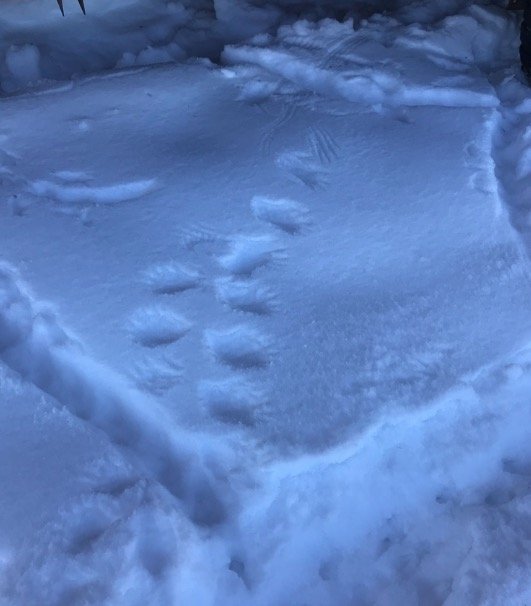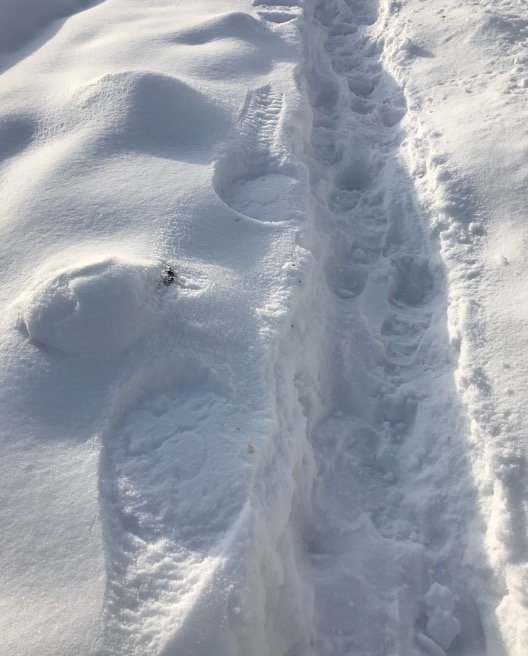Dear Farm Friends
It’s been a busy start to winter, and a long time since a newsletter. As sometimes happens in that case, we had a lot of words built up, so there’s a long-read section at the end of the email, and shorter newsy bits up front here.
If you haven’t been to the farmstore in a while, you might be wondering if it’s worth the trip. After all, there has been snow on the ground since early November, many nights well below zero, and light levels so low that some days one more cup of coffee is the only thing preventing us all from crawling into hibernation on the couch with the farm cats. But it’s definitely worth coming to the farm!
Even with all the greens, we’ve been digging into the grated-roots salads lately. Fun grated rainbow carrot arrangements bring that summer sun back, and love a good honey-mustard or ginger dressing with sesame oil and rice vinegar.
The farmstore is stocked, even crowded, with storage crops from carrots, beets, radishes, potatoes, cabbage, to squash, onions, and garlic. There are also fresh greens, including our mild winter salad mix and a chard-kale cooking mix at the moment, with spinach preparing to return this week. We’ve gotten so used to this, in some ways, that it just seems normal to have 3-4 different kinds of greens in mid-December, but it was not many years ago that the farmstore at this time of year held, at best, some squash, onions, eggs, and potatoes.
We still have a few beautiful garlic braids available, great for gifting or just combining decoration and flavor in your own kitchen. SRF hoodies are available again too.
We encourage you to come on out in the coming weeks as we make some of our final large greens harvests for the year. With some crew taking time at the holidays to be with family and friends, we will take a one-week hiatus from greens harvests in the week between Christmas and New Year’s Day, and anticipate January being quite a bit lighter on greens, though the spinach forecast is promising (more details on how that is possible, below).
One of things that can still surprise us about being a four-season farm is how….I won’t say easy it is to provide year-round food to our community, but at least how imminently possible it is. We are wrapping up our first 8-week winter membership session this week, in which farm members picked up weekly feasts of roots, squash, onions, garlic, greens, and more. The next session will start on the first Wednesday of January. We currently have about 15 spaces free, so if you want to start your year off with a weekly dose of local veggies, check out the details and simple signup form on here our website.
Whether you join the winter membership, or just stop by the farmstore, we are excited to have so much variety and abundance for you: winter squash, onions, garlic, beets, carrots, radishes cabbage, salad turnips, and a wide variety of potatoes.
This winter we find ourselves not only winter-farming, but also winter-building, making it still a little bit hard to achieve the winter-resting that we know we need. We’ve been managing concurrent teams on the farm and on the build. We’re extra grateful that the farm team is able to handle enough of the daily tasks that this Friday we were able to have some key strategy talks together, and also sneak away for a short little ski up Skalkaho.
The packshed build continues, and continues to be our largest, most complicated project yet. After an entire long week of blowing in cellulose insulation, the space now stays warm with just occasional firings of the natural gas heater; some days we even warm it up with just a simple box fan blowing in from the greenhouse. It’s exciting especially in contrast to our current setup in our old seed-starting greenhouse, thawing out hoses and sink drains and greens spinners with the pellet stove and torpedo heaters in advance of each greens-rinsing session. It’s exciting to imagine working and storing produce in there, and yet it feels quite a ways off yet, with all the stages of finishing.
In other farm news, we continue to ask that you be patient with egg availability. There are simply more of you than the hens can keep up with, especially in the darkest part of the year. We are down from 30 dozen eggs a day to 6-8 dozen, while you all have only gotten hungrier. There is hope on the horizon in the form of an order for hatched chicks to arrive in late January (still requires patience, they’ll be laying in June), to bring market-season production back up. Till then, just please be aware that eggs are sold out more often than not at the farmstore, so we do not recommend a trip if eggs are your only goal.
To wrap up this first section, we want to thank you all for an amazing year and season. Though it was a stressful and exhausting one, it has also been productive, abundant, and included lots of growth and learning both in and out of the field.
We say it so often, but we couldn’t do all of this without you, and we continue to be amazed at how deeply we have been woven into the community here over the years. This week, we combined a delivery to the BitterRoot Brewery on Thursday with a dinner. The Brewery has a special place in our history here; we used to eat there while in the process of moving our homestead-scale farm and our lives from Missoula to the Bitterroot. It was a dark and lonely winter, 9 years ago now, when we signed papers on these ten acres and started this adventure with no real idea of where we were headed. We usually felt a bit lost and alone when we’d take refuge in the warmth of the brewery. In contrast, on Thursday in the course of one beer and some great food (including some of our vegetables), we counted 5 farm members visible, recognized many more faces from market or around own, got several big hugs and a visit from Chef Toby, and discovered on receiving the bill that our dinners had been covered. It has happened gradually, slowly but firmly, we’ve become a part of this place.
Thank you all,
Mary and Noah, SweetRoot Farm
Read on below for some wordier news and thoughts, or scan through for the photos of winter greenhouse building.
PSA: Are you missing some ornaments? When we take in grocery bags for re-use, we sometimes find surprises, but usually just old grocery lists or receipts, the occasional pair of reading glasses. Sometime this season, someone dropped off a batch of re-use bags that happened to include a bag also full of tissue paper and Chrismtas ornaments. If you recognize these and can help them find their way home, please reach out! Many are handmade, and we are especially impressed with the moss-and-twig hedgehog, so if someone is missing them we’d love to help return them.
Winter Farming, Winter Driving, and the world’s worst roller-coaster ride.
Snow and ice were rare in western Oregon, so I grew up believing that winter driving was a complex skill requiring ninja-like reflexes and the daring of a stunt-double. Drivers’ Ed class glossed over it with some vague mentions of “steering into the skid” which made very little sense to a 15-year-old driver barely capable of smooth signaling and lane changes. It reinforced the idea that snowy driving was akin to the police chase scenes in cheesy movies. As a child excited by every rare snowfall and frozen puddle to arrive in the Willamette Valley, it was no surprise that I gravitated towards places with “real winter” as I grew up. Settling into Michigan and then Montana with my little ‘86 Subaru, I was a bit surprised to learn that 99% of winter driving is simply moving slower, planning ahead, and being prepared for the unexpected. Although the occasional incident required quick reflexes and flash decisions, the vast majority of it is simply slowing down and leaving space. Sometimes it even just means staying home and not driving, waiting for a better window, or changing the route. Of course it’s easier, better, and safer with the right equipment, but it’s not rocket science after all.
When we first met farmers who grew year-round, we felt like winter growing was also a magical out-of-reach thing done by farmers with extreme skills or exceptional locations. We were intrigued by four-season farming from the start, but for a long time saw it as a distant-future possibility, or maybe something that was easy in clear sunny Colorado, but not here. But then in 2019 a mid-season hailstorm forced us to venture into winter greens production to cover lost production from July. Following the advice of Elliot Coleman’s Winter Harvest Handbook, and that of two farmers we knew who were year-round producers in NE Washington and the Idaho panhandle, we were in some ways almost shocked to discover that winter growing, just like winter driving, is less mad-skills, daring, and badass-ness, and mostly about planning ahead, being prepared, and knowing that many things will just take longer. Often it means changing the harvest schedule to take advantage of a good window of weather or avoid a bad one, and it does require a lot more flexibility and planning ahead than June harvests.
Having the right equipment and facilities makes it easier and more reliable (we don’t have quite all of that yet, but it’s a big reason for the packshed build). But in the end, we don’t have all these vegetables in December because we have some wild skills or special training. While we do appreciate the compliments, we really aren’t that amazing. We just keep chugging along as best we can, well below the speed limit and always on alert. We have storage crops thanks to everyone’s hard work in the summer and fall, and we have winter fresh greens because we do some really simple basic work: we tromp out through the snow in our thick boots, break the frost on the greenhouse doors, and stick to our daily ritual of row cover off for the sun, back on over the plants an hour before sunset. We have learned how to judge when the greens have thawed enough to harvest, and we watch the forecasts with careful analysis to understand when they will be thawed enough to harvest for you. It’s not rocket science or stunt driving so much as simply continuing to chug along through any conditions.
Currently we are able to rinse those greens for you only if we plan ahead, leave extra time, and thaw out the old greenhouse we use now for our wash-pack area, and remember to drain the hoses for the next round. We are so looking forward to a day when we can wash and pack in an insulated, heated building…it might be the equivalent of getting new snow tires.
There are moments that can feel a little extreme, like when we built a new, 6th caterpillar tunnel in late November, over the 4 beds of field spinach buried under 10-12 inches of snow (photos below, click to cycle through all the images and hover for captions.).
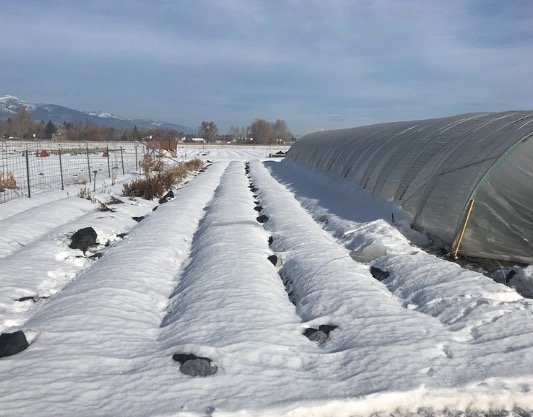
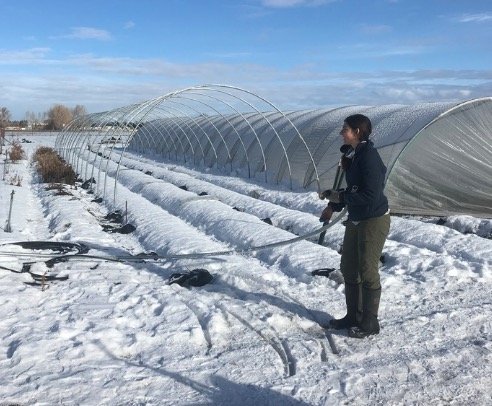
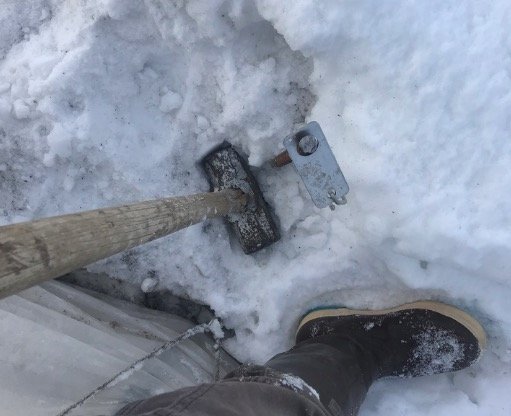
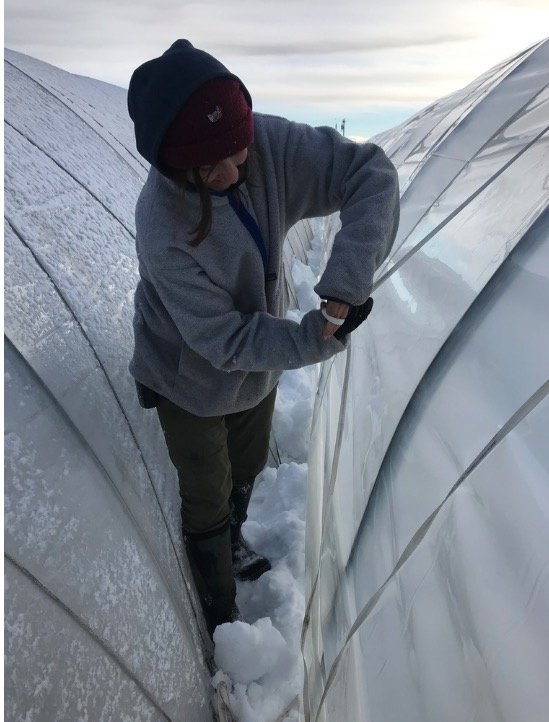
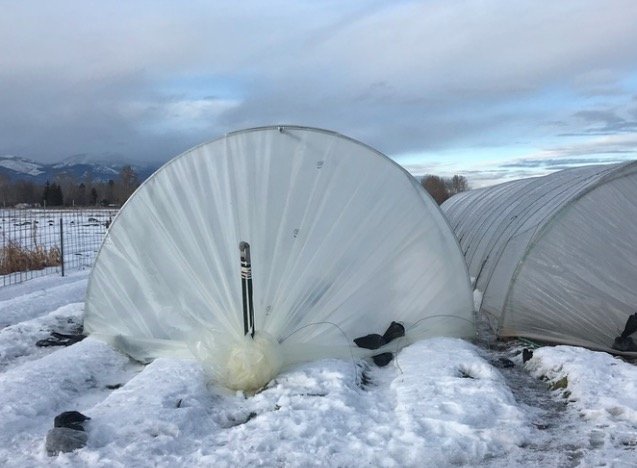
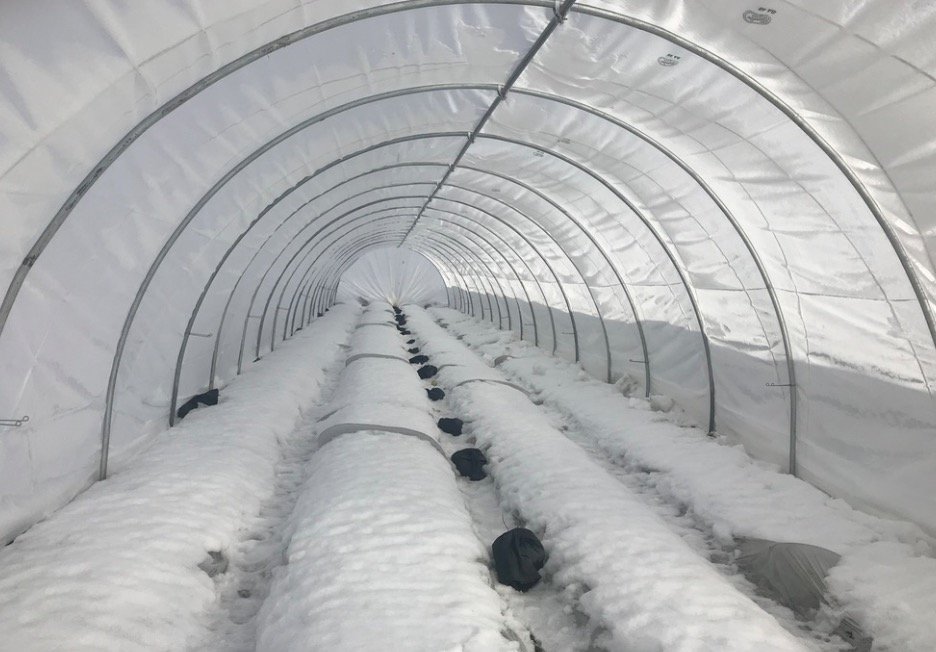
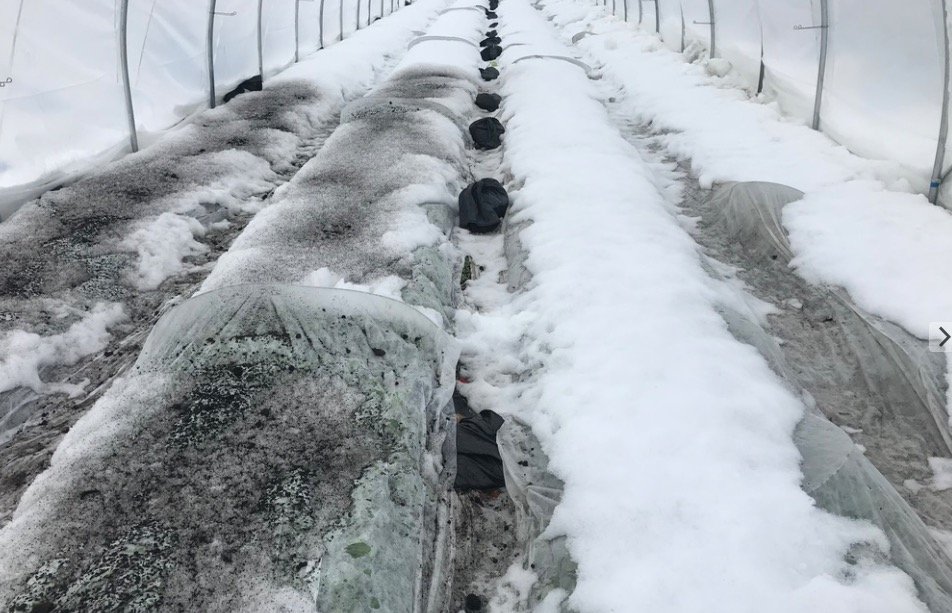
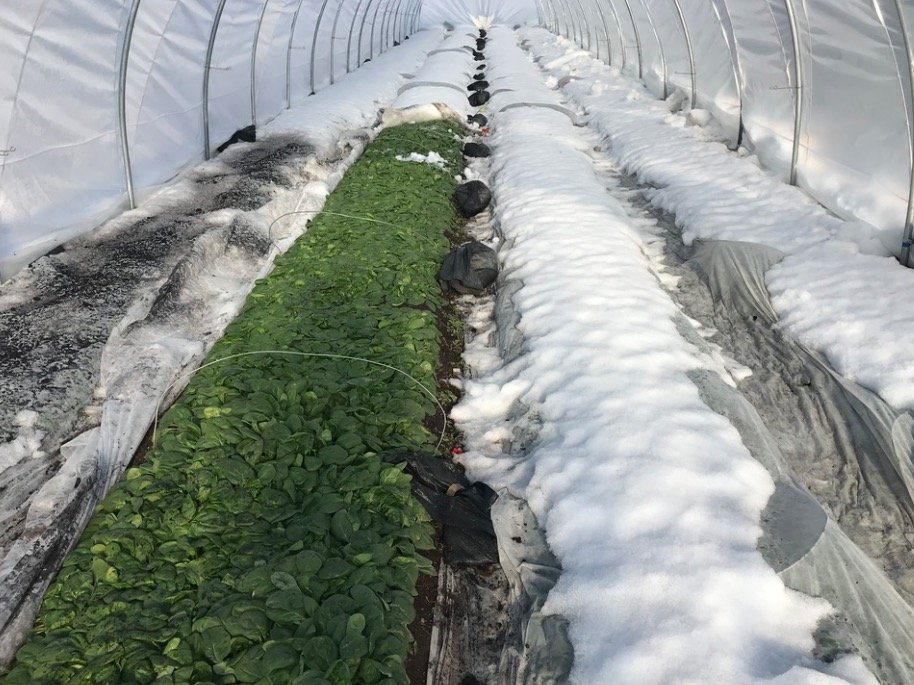
But no matter how much planning and preparation, no matter how much space you’ve left for braking, winter driving always brings that risk of a patch of black ice on the corner, the dreaded feeling of floating off track, bracing for impact and uncertain how bad it might end up.
Back in late November, we hit a farming equivalent of a patch of black ice: Sabrina had gone to our rented walk-in cooler to pick up bulk beets, carrots, cabbage, etc. for stocking the farmstore for Thanksgiving, and filling our winter CSA shares that week. She called to alert us that something was very wrong: the outer layers of all the stored cabbage seemed frozen, and bags of roots in at least half the cooler had frost on the plastic bags, and some bags seemed frozen solid inside too. We felt the road, already tricky enough this winter, start to slip out from under us; almost all of our carrots, beets, and radishes were there, more than half of our cabbage. We told her to bring back some bags that seemed ok to fill that week’s plans, and to bring back some of the worst looking too, so we’d know what we were in for. We then drove over ourselves, trying not to panic, but counting up from memory the number of pallet-bins and calculating the thousands of dollars of potential loss. Trying to calculate what we could do to make it all up, what the loss might mean, all the while trying to believe it might not be that bad.
Food, at our scale of farm, can be measured in a lot of ways: pounds, bushels, totes, or dollars; the most poignant is the measure of hours or days, units of human effort. People worked hard for that food, much of it had already been paid for by and promised to people in our winter membership, and the thought of all that effort, the mental image of our whole team kneeling in the snow in late October pulling bulk carrots from the ground…the thought that that effort could be lost was what made the breath catch in our throats, our stomachs drop. Caused me to roar an angry scream out across the snowy field, to curse uncharacteristically in that walk-in cooler as carrots registered frozen-solid and 27-28 degrees in their centers, bag after bag. Caused me to hurl a cabbage with leaves, frozen all the way to the core, viciously into the back of our track bed where it shattered and remained for a full week.
We are as guilty as anyone of using the inaccurate metaphor of farming as an emotional roller coaster. It’s inaccurate because the whole premise of a roller coaster is tapping into primal fears while also knowing and trusting that in fact you are safe. You experience the sensations of free-fall but know at some level you will be safely brought back to earth. Farming is more like driving than a roller coaster. There are safety measures, for sure, but when you start to slide there is no guarantee; maybe you’ll coast safely to a stop on the shoulder, but you could truly fly off the edge. The emotions may go up and down as much as a roller coaster ride, but the consequences could in fact be real.
In the end, amazingly enough, after a very slow and careful thaw, it appears we only suffered real damage on 500-800 pounds of produce, not the roughly 7,000 pounds that were stored there. We got lucky that Sabrina caught it when she did, that we were able to install our own frost-protection system in the cooler, and that much of the produce that was frosted but not frozen solid, or not for too long, seems to be holding fine after the thaw.
But we really never want to go through that again. The first portion of our packshed that will be finished and functional is the new/ reclaimed walk-in cooler. The greatest, perhaps even only, Christmas present we’ll be trying to give ourselves this week is to move all of our produce back to the farm, to this new cooler that we can check easily multiple times a day, where the cooler is inside a super-insulated building with a heater running on a thermostat.
We’ll never be able to eliminate risks from farming, that’s not how the whole thing works. But as we continue to grow and develop as a farm, we keep weaving more and more into our safety net. When it looked for a few days that we might very well have lost half our winter storage roots, a substantial part of our winter income plan, we felt pretty alone. But as we emerged, with both less damage than feared, and a suite of plans in case it was that bad (and that was the final straw of motivation for building the caterpillar tunnel over that field spinach), we were reminded over and over again by people’s appreciation, warm greetings, and thanks, that we’re a deep part of this community now too, and while there are no safety rails, no guarantees, there are a lot of hands and hearts here ready to help dig us out, push up back on the road, however they can. That’s real. A roller coaster doesn’t give you that, either, so we’ll continue to stay off the rides and on the road, wild as it is.
Snowy farm tracks in the daily rounds: left, the wingbeats of a quail flushing out from under a chicken barn to take flight, crossing the heavy plodding tracks of a hen. Right: snow deep enough that any farmer under 5’10 carrying 5 gallon buckets of water to the chickens can briefly rest the bucket on top of the snowy growing beds with each step.





